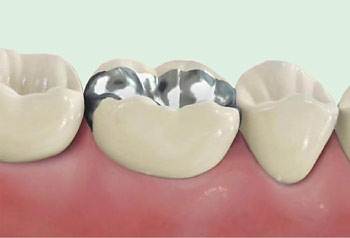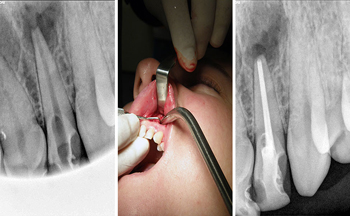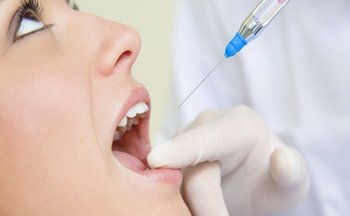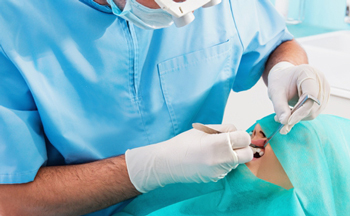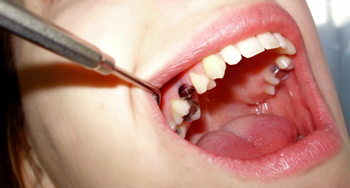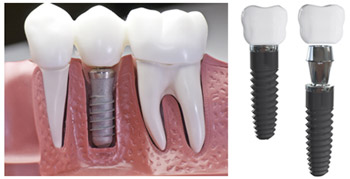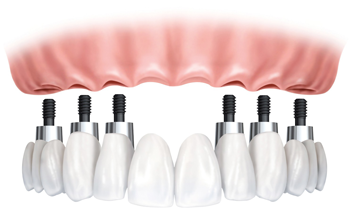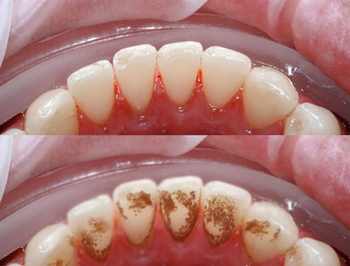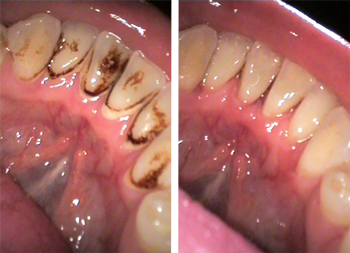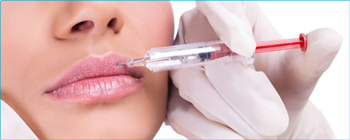Dental clinic Maglajlić covers all aspects of conservative dentistry using materials of high quality, modern equipment and techniques. Conservative dentistry is a branch of dentistry which includes diagnostics and treatment therapy. Together with endodontics ( the dental nerve treatment) it represents the area dentists mostly deal with in everyday work. Final aim of conservative dentistry and endodontics is compensation and rehabilitation of hard and soft dental tissues in a conservative way, ( e. g. without surgical or prosthetic interventions) and restoration of a teeth function.
Amalgam restoration ( gray fillings)
Amalgam fillings ( gray fillings) have been used for years in everyday life. They represent metal alloy made of silver and mercury. Mechanical endurance of amalgam is very good so fillings can last for decades. Material is easy to work with and it doesn’t require ideal conditions for placing it into the tooth.
However, ‘ gray filling’ ( the way amalgam is usually called ) is not satisfactory solution nowadays. There are many flaws of amalgam but surely the most important one is the crack which in time starts to show between filling and a tooth. That crack occurs due to material contraction. The other significant flaw is the need for mechanical tooth retention . In fact, amalgam filling doesn’t establish a chemical bond with dental tissue but it is simply ‘put’ into the removed part of the tooth. It often requires removing the piece of the healthy tooth to keep the amalgam filling stable.
Although toxicity of amalgam is minimal, it is being discarded from use in the US and the Western European countries because it contains a certain amount of mercury. And in the end, the biggest flaw that bothers patients is unsatisfactory aesthetics – besides noticable ‘ gray filling’, additional problem represents the fact that, in time, surrounding healthy dental tissue begins to darken taking over the colour from amalgam.
Composite restoration (white filling)
On the other hand, composite restoration ( ‘white filling’) represent solution to the problem which we face while using amalgam. The truth is that older generations of white fillings also had some flaws which were especially related to weaker durability under the chewing pressure and that was the reason why they were only used for front teeth where the pressure is not so big. However, the newest generations of composite fillings ( 4th and 5th generation is used nowadays) solved the problem of durability under pressure so they represent a material which completely meets all requirements of modern dentistry.
It should be pointed out that composite establishes chemical bond with a tooth so there is no need for removing the healthy tissue which is the case with amalgam. Established chemical bond represents a strong juncture of filling and tooth, and being what it is, it stops the additional penetration of bacteria. Because of that, secondary caries appears less ( caries at the edge of the filling, which often happens with amalgam fillings). Aesthetic advantages of ‘ white filling’ compared to amalgam don’t have to be pointed out much. Thanks to specific crystal structure they are made of, modern composites with so – called chameleon effect imitate the colour of surrounding healthy dental tissue keeping a superior mechanical and biological properties.
Inlay and Onlay
Inlay and onlay represent, together with amalgam and composite restorations, another solution for compensating the part of the tooth lost due to caries. Couple of decades ago, this technique was often used and construction material was gold. Development of aesthetic materials of high quality made possible for the inlay and outlay restorations to be used in everyday practice. Ceramic and composite materials which perfectly match healthy dental tissue are being used instead of gold.
Difference between fillings and these restorations is in a production process. Based on a a toothprint taken in the clinic after tooth preparation, inlay is being made in dental labaratory. Labaratory production makes it possible to aquire almost perfectly authentic shape of restoration so it sometimes happens that even dentists themselves can’t recognize inlay in a mouth. Hence, precision of production is a basic advantage of these restorations. On the other hand, this process demands more time because of longer work in the clinic ( besides removing a tooth impairment, jawprint is also taken) and because the sample is sent to the labaratory where restoration is being made. After a few days, restoration is ready for cementating in the mouth.
We proudly point out that Dental clinic Maglajlić is especially known for its high quality prosthetic services and a great number of satisfied patients to whom we returned smile using contemporary prosthetic procedures. Dental prosthetics is a branch of dentistry that primarily deals with the replacement of missing teeth with prosthetic compensations. Every missing tooth has to be replaced as soon as possible because, otherwise , negative changes start to develop and effect neighbouring teeth, matching teeth in the opposite jaw as well as mandible joint. Another, very common reason for production of prosthetic compensations is the aesthetic imperfection of existing teeth ( inadequate colour, shape and position of the tooth). We divide all prosthetic compensations into two groups : fixed and mobile compensations. Fixed compensations ( crowns and bridges) are cemented in a mouth and they don’t have to be removed after the installation, while mobile compensations (dentures) can and should be removed from the mouth on daily basis, in order for a patient to perform certain hygiene measures.
Fixed compensations – crowns and bridges
Crowns ( or onlays, as they are often called) are made in cases in which natural tooth is greatly damaged ( mostly due to caries or fraction etc.) or for aesthetic reasons ( unsatisfactory colour or shape of the tooth). If the tooth was previously devitalized ( the root was taken out ), it is recommendable to strengthen it with an extension, i.e. with a stick which is placed in a root canal, and then to cement the artificial crown.
A bridge is restoration which consists of several connected crowns. It is used in cases where one or several teeth are missing and the toothless space is surrounded with natural teeth that will be used as bridge support on both sides.
In general, crowns and bridges can be metal ceramic and non – metal ceramic restorations. In the case of metal ceramic restorations, a ceramic layer is applied to metal substructure and it completely covers the metal so it is not visible in the mouth. In this way, durability of metal is ensured and, at the same time, an aesthetic effect is accomplished thanks to ceramic on the surface. In addition to high endurance and excellent aesthetics, these restorations are also financially acceptable and therefore most frequently chosen by the patients. Development of new materials has enabled the production of non – metal ceramic restorations. New kinds of ceramics, which guarantee hardness and durability of metal and also have excellent aesthetic features, are made. Thanks to this, restorations which also have ceramic substructure are produced nowadays, thus allowing the ceramic surface layer to be partially transparent. This combination is the most similar to the natural tooth so non – metal ceramic restorations are the best thing modern dentistry can offer at the moment. Read more about non – metal ceramic here..
Regardless of the material, when there is a need for prosthetic work , fixed restorations i. e. crowns and bridges are definitely the most desirable solution, in terms of both function and aesthetic. In addition, they are much more comfortable for the patients than mobile restorations so they are always the first choice .
Mobile restorations- dentures
Dentures are divided into total and partial.Total dentures are made in cases of total edentulism ( all teeth are missing) while partial denture is the solution for the patients who have certain ( smaller ) number of teeth. Partial dentures are connected to the rest of the teeth with hooks or braces and can be acrylic or skeletal ( known as wisil). The partial acrylic denture is made entirely of acryl and as such is less resistable than skeletal. That’s why it is less used nowadays, but its advantage is economic accessability. Its production is mostly recommended as a temporary solution until conditions for some more permanent and quality work are achieved ( e.g.immediately after tooth extractions, until wounds are healed). Partial skeletal ( wisil) denture is more quality solution because, in addition to longer durability ( obtained by installed metal skeleton ), patients are provided with greater comfort due to smaller surface of the part of the denture which adjoins on soft tissues (on palate, sublingual region ). In this way, the feeling of foreign body in the mouth is reduced. Another advantage is possibility of attaching it to the remaining natural teeth with more precisely manufactured cast hooks which provides much better stability in the mouth. Instead of hooks, attachments (braces) can be installed to skeletal dentures as even better connection to adjacent teeth. Attachments keep dentures firm and stable in the mouth and they are hidden in a part of the denture which is not visible from the outside.
Teeth bleaching
Do you know that over 50% of people pay attention to your smile while talking to you? Beautiful,white teeth are certainly the thing that can make your smile impressive. Every person looks younger, more attractive and healthier if he/she has white teeth. On the other hand, dark and yellow teeth will definately make you look older and unattractive. Unfortunately, we had perfectly white teeth only in our childhood, because in time, despite ideally maintained hygiene, teeth change colour and become darker. Reasons for this are pigments in food and drink ( coffee, tea, black wine, coloured juice etc.), then tobacco, aging, some bacteria, medications etc.
Fortunately nowadays, it is really simple, in most cases, to regain teeth whiteness we once had. There are number of methods which can be used for easy and effective elimination of coloured teeth, and the base of each one of them is an impact of chemical substances – hydrogen peroxide, carbamide peroxide or sodium perborate. Everything else involved in teeth whitening ( lamps, lasers etc.) represent only an auxiliary equipment, and in some cases, a pure marketing tactic. What’s most important is the fact that all these techniques really work, without any risk to the health of patients’ teeth and this is guaranteed by millions of patients who smile happily now. Of course, every procedure is performed only after a detailed examination at the dental clinic, under dentist’s supervision and respecting the dentist’s recommendations. The detailed dental examination is necessary because bleaching substances can cause damage only on teeth with cavities or with old cracked fillings.
Bleaching of all teeth
Teeth bleaching can be performed in a dental clinic ( in – office bleaching ) or at home ( home bleaching ). If it is is performed in a dental clinic, bleaching gel is applied directly to the teeth 20 to 45 minutes. The procedure can be repeated in several sessions. If it is performed at home, the procedure is as foollows : a mould is taken in a dental clinic based on which the individual tray is made. The bleaching gel is placed in the tray and held in the mouth usually during the night ( 7 – 8 hours), although there is also an alternative use in which you can hold it during the day ( 20 minutes to an hour) with slightly more concentrated bleaching gel. The tray with the bleaching gel is used 7 to 15 days althogether, depending on the intesity of the coloration of the teeth before bleaching, as well as shade a person wants to accomplish. The difference between bleaching in the dental clinic and at home is in the concentration of active substance in gel. Naturally, the concentration is lower in home bleaching so procedure itself takes longer but , in any case, the final outcome is excellent.
Bleaching of single teeth
There are cases when only certain teeth have darker colour. It can be natural phenomenon ( for example, canines are often the yellowest teeth in a row) but it often happens as a result of devitalization, i.e. tooth ‘ treatment’ ( extraction of tooth nerve). This relatively common aesthetic problem mostly occurs because of the late beginning of the treatment ( i. e. when tooth infection progressed ), but it can also be a result of medications used in treatment as well as possible internal haemorrhage in the tooth due to trauma. So, it is useful for the dentist to conduct certain teeth protection measures while treating teeth, and also not to use medications which can cause subsequent change of teeth colour. If these instructions are followed, the coloration of devitalized teeth either won’t happen at all or it will happen in much less extent.
But if the coloration happens, there is also a solution for that. The procedure for bleaching is the following: at your first visit to a dental clinic, a dentist will prepare a chamber ( a cavity) on the inner side of the tooth, whereupon bleaching gel will be placed. After that ,the chamber will be temporarily closed for two days. Then, the procedure is repeated, i.e. the gel is removed in the clinic and the new one is placed in the tooth because the dentist has to perform couple of sessions in order to achieve the desired goal. When a satisfactory objective is achieved, it is advisable to replace the inlay ( the filling) as the old one contributes to inappropriate appearance and bad colour of the tooth. In addition, if the crown of the natural tooth is largely removed, we recommend an installation of fiberglass sticks which will strengthen the tooth. This way we gain fully functional and aesthetically acceptable cured tooth.
Oral surgery includes:
- Removal of the frenulum
- Apicoectomy
- Complex tooth extraction
- Hemisection
- Ridge alignment
Dental implants
Dental implants certainly represent the best solution in cases of missing teeth. Implants are screw – like titanium compensations which are placed in a jawbone with a purpose of imitating natural root of the missing tooth. After the jawbone and implant coalescence, an adequate compensation is placed on the implant. It can be single crown, bridge or denture. This way, a re – function of missing teeth is ensured. New tooth on the implant entirely looks and functions as a natural one. In cases where several teeth in a row are missing, it is not necessary to install as many implants. Two implants can carry one bridge with three or four teeth.
Benefits of implants
compared to other ways of compensation for missing teeth:
- After tooth extraction, jawbone on the place of the missing tooth recedes over time. This phenomenon is prevented only if implant is installed .
- If the missing tooth is compensated with an implant, it is not necessary to treat the neighbouring teeth( and damage them that way) in order for them to become bridge support .
- Artificial teeth on implants are fixed compensations which means that they are not taken out after installing (unlike dentures) and in that way provide sense of security for patients.
- Even in cases of complete toothlessness, when patient already uses a denture, implants can be placed and used as denture clasps. The dentures stabilized in this way do not slip off while talking and chewing. Two things are considered as disadvantages of implants – costs and time. The price of implants is higher compared to dentures or bridges as alternative solutions. But the thing that has to be taken into concern is that implants are lifetime solutions which can only be jeopardized by patient’s improper hygiene. On the other hand, dentures, due to constant and unstoppable recession of the jawbone underneath them, become more and more loose over time so patients feel insecure and dissatisfied. The solution for this are constant corrections and after a period of time, production of completely new denture which brings additional costs. When it comes to bridges carried by natural teeth , there is primarily a dilemma – is it worth treating two natural teeth in order to compensate for one that is missing? It is especially tricky question if those two teeth are completely healthy. The value of healthy natural teeth cannot be expressed in money. In addition, such teeth, after placing the bridge and during the usage, undergo the pressure anticipated also for the extracted tooth, so it happens that they too become jeopardized in time. It is often necessary to remove the existing bridge, extract one or both carriers which decayed during use and then make new, even bigger bridge and so again and again. However, such development of events takes a bit longer and that’s why patients don’t often fully consider the situation when it comes to costs. A justification of teeth treatment and the role of teeth as bridge carriers can be accepted without dilemma only in cases when natural teeth chosen to be the carriers of the future bridge have already been damaged by extensive caries or they have large fillings. Therefore, compared to other alternatives, implant replacements of tooth cannot be rejected just because of the total cost. Even when a larger number of implants or an artificial bone, which is used as a compensation for missing natural bone after longer time of toothlessness, are needed , a quality, durability and overall benefit for the patient who receives implant therapy is incomparably bigger than the other alternatives. Regarding the time needed for the missing teeth to be replaced with implants, there are certain limitations that don’t go in favor of implants. The period required for osteointegration ( implant and bone coalescence ) is 2 -6 months, depending on the case.Only after this period of time, an artificial crown can be placed on the implant without fear of implant rejection. A success of implantation, if this procedure is followed, is over 99%. During the osteointegration, the patient can carry a temporary aesthetic compensation. Although there are people who support putting weights on implants, i. e. placing of an artificial crown or bridge immediately after the installation, the fact is that the percentage of implantation success rate is lower. Taking into concern all benefits of implant therapy, it is safe to say that it is currently the best way to compensate for the missing teeth, both in aesthetic and functional terms.
Treatment and prevention of periodontal disease
Removing of dental calculus , a resective therapy without applying regenerative material, regenerative therapy, SMAT, TVT ( surgical solution for receding gums problems),removal of the frenulum etc.
Preventive dentistry
Sealing children’s fissures , removing of dental calculus, education on proper tooth brushing techniques…
Fixed orthodontic appliances
Fixed orthodontic appliances are devices which cannot be removed until the end of orthodontic therapy, i.e. they are attached to the teeth surface the whole time. They consist of brackets which are glued to the tooth surface whereupon a thin wire, i.e. archwire is then placed. During regular examinations, orthodontist replaces archwires that effect teeth with mild but continuous forces due to which moving of the teeth occurs. Duration of the therapy depends on an individual case and changes we want to achieve, and it approximately lasts for a year or year and a half. In cases of mild irregularities, the results can be achieved in less than a year, but on the other hand, there are more extreme cases where devices need to be worn for two or three years. An ideal period for the beginning of the therapy is after emergence of Second Molars, around the age of 13. There is practically no upper age limit, so fixed devices can be successfully applied even in fourth or fifth decade. There are various indications for applying the fixed orthodonic devices, from correcting teeth and gaining perfect teeth alignment to closing spaces between certain teeth. There are almost no limitations, except the need for maintaining an excellent oral hygiene and good condition of teeth and supporting dental tissues ( gingivae and jawbones). In cases where patients have many bad teeth or do not maintain oral hygiene well, appliance is not recommended until existing state is improved, i.e. until teeth are repaired and hygiene enhanced. After setting up a fixed device, teeth have to be brushed after each meal, and sticky candies and nuts ( peanuts, almonds, walnuts etc.) should be avoided in the diet as they may cause a bracket to fall off. These are at the same time the only limitations for having a fixed appliance. Patients get used to appliance very quickly and they don’t even notice it after seven days.
At our dental clinic, we use three kinds of fixed orthodontic appliances:
- classical nickel – titanium ( metal) appliances
- aesthetic ( ceramic, white ) appliances
- Damon appliances
NEW!!!
Aligners for correction of mild dental irregularities

Hyaluronic fillers
Hyaluronic fillers represent hyaluronic acid in a form of gel.
Hyaluronic acid is a component of every organism and over 50% of it is found in the skin.
Hyaluronic fillers can be injected in all areas of the face, and apart from the face, they can be used in treatment of the area of the neck, neckline or fists. The aim of the fillers is to compensate for the loss of subcutaneous fat tissue and to fill in skin defects developed during skin aging. Application of fillers can compensate for volume deficiency, i.e. skin tonus, and it can be used for fiiling in the wrinkles.
Hyaluronic fillers they are used for filling in wrinkles between the eyebrows, nasolabial wrinkles, wrinkles around mouth and smile line wrinkles.
They are used for filling in cheecks; a chin and lower jaw line can be made flatter and tighter and they are also used for augmentation and correction of the lips.

